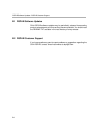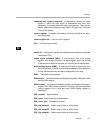
Fractional Q Formats
A-3Performance/Fractional Q Formats
A.2 Fractional Q Formats
Unless specifically noted, DSPLIB functions use Q15 format, or to be more
exact, Q0.15. In a Qm.n format, there are m bits used to represent the two’s
complement integer portion of the number, and n bits used to represent the
two’s complement fractional portion. m+n+1 bits are needed to store a general
Qm.n number. The extra bit is needed to store the sign of the number in the
most-significant bit position. The representable integer range is specified by
(−2
m
,2
m
) and the finest fractional resolution is 2
−n
.
For example, the most commonly used format is Q.15. Q.15 means that a
16-bit word is used to express a signed number between positive and negative
one. The most-significant binary digit is interpreted as the sign bit in any Q
format number. Thus, in Q.15 format, the decimal point is placed immediately
to the right of the sign bit. The fractional portion to the right of the sign bit is
stored in regular two’s complement format.
A.2.1 Q3.12 Format
Q.3.12 format places the sign bit after the fourth binary digit from the right, and
the next 12 bits contain the two’s complement fractional component. The
approximate allowable range of numbers in Q.3.12 representation is (−8,8)
and the finest fractional resolution is 2
−12
= 2.441 × 10
−4
.
Table A−1. Q3.12 Bit Fields
Bit 15 14 13 12 11 10 9 … 0
Value S I3 I2 I1 Q11 Q10 Q9 … Q0
A.2.2 Q.15 Format
Q.15 format places the sign bit at the leftmost binary digit, and the next 15
leftmost bits contain the two’s complement fractional component. The
approximate allowable range of numbers in Q.15 representation is (−1,1) and
the finest fractional resolution is 2
−15
= 3.05 × 10
−5
.
Table A−2. Q.15 Bit Fields
Bit 15 14 13 12 11 10 9 … 0
Value S Q14 Q13 Q12 Q11 Q10 Q9 … Q0


















